lock CHEVROLET SILVERADO 2000 1.G Owners Manual
[x] Cancel search | Manufacturer: CHEVROLET, Model Year: 2000, Model line: SILVERADO, Model: CHEVROLET SILVERADO 2000 1.GPages: 421, PDF Size: 2.87 MB
Page 3 of 421
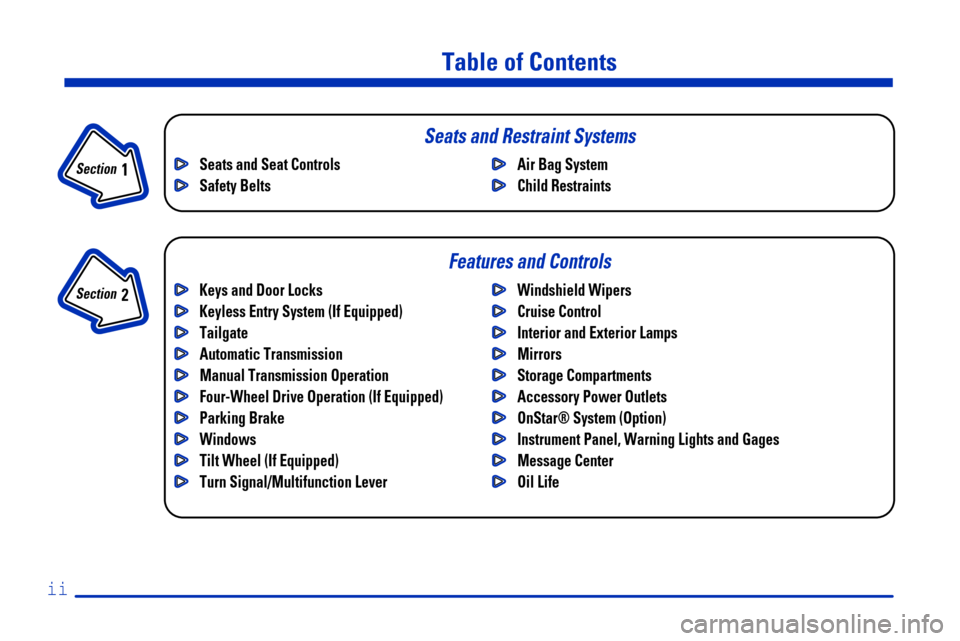
ii
Table of Contents
Keys and Door Locks
Keyless Entry System (If Equipped)
Tailgate
Automatic Transmission
Manual Transmission Operation
Four-Wheel Drive Operation (If Equipped)
Parking Brake
Windows
Tilt Wheel (If Equipped)
Turn Signal/Multifunction LeverWindshield Wipers
Cruise Control
Interior and Exterior Lamps
Mirrors
Storage Compartments
Accessory Power Outlets
OnStar® System (Option)
Instrument Panel, Warning Lights and Gages
Message Center
Oil Life Seats and Seat Controls
Safety BeltsAir Bag System
Child Restraints
Section
1
Section
2
Seats and Restraint Systems
Features and Controls
Page 4 of 421
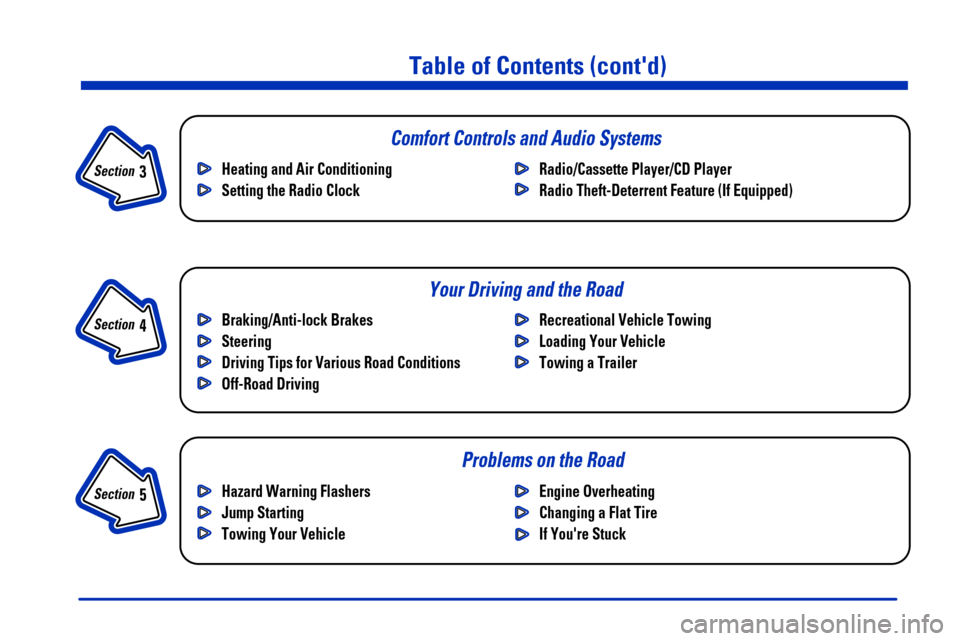
iii
Section
3
Comfort Controls and Audio Systems
Section
4
Your Driving and the Road
Section
5
Table of Contents (cont'd)
Braking/Anti-lock Brakes
Steering
Driving Tips for Various Road Conditions
Off-Road DrivingRecreational Vehicle Towing
Loading Your Vehicle
Towing a Trailer Heating and Air Conditioning
Setting the Radio ClockRadio/Cassette Player/CD Player
Radio Theft-Deterrent Feature (If Equipped)
Hazard Warning Flashers
Jump Starting
Towing Your VehicleEngine Overheating
Changing a Flat Tire
If You're Stuck
Problems on the Road
Page 10 of 421
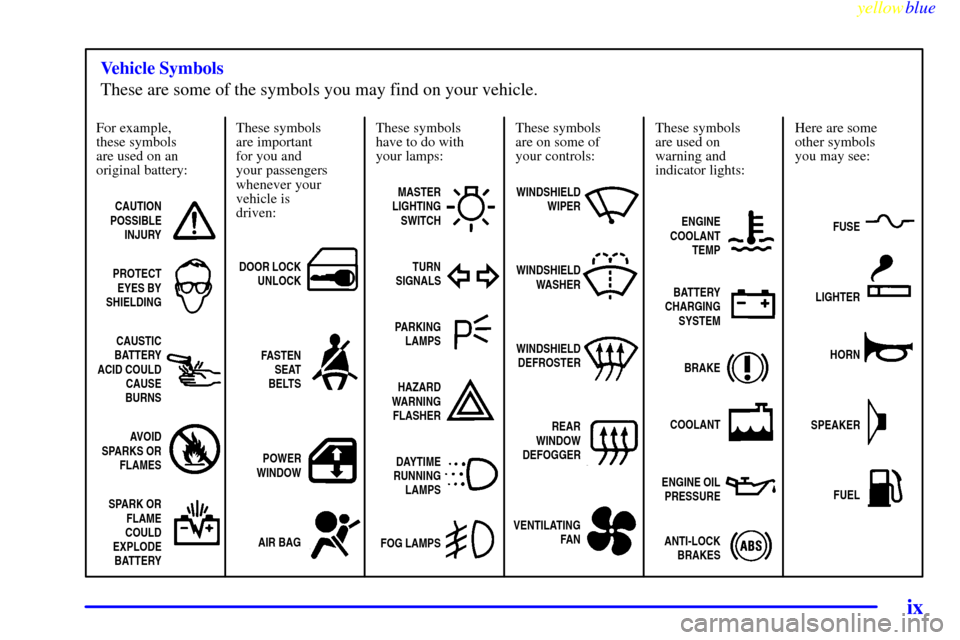
yellowblue
ix
For example,
these symbols
are used on an
original battery:
CAUTION
POSSIBLE
INJURY
PROTECT
EYES BY
SHIELDING
CAUSTIC
BATTERY
ACID COULD
CAUSE
BURNS
AVOID
SPARKS OR
FLAMES
SPARK OR
FLAME
COULD
EXPLODE
BATTERY
These symbols
are important
for you and
your passengers
whenever your
vehicle is
driven:
DOOR LOCK
UNLOCK
FASTEN
SEAT
BELTS
POWER
WINDOW
AIR BAG
These symbols
have to do with
your lamps:
MASTER
LIGHTING
SWITCH
TURN
SIGNALS
PARKING
LAMPS
HAZARD
WARNING
FLASHER
DAYTIME
RUNNING
LAMPS
FOG LAMPS
These symbols
are on some of
your controls:
WINDSHIELD
WIPER
WINDSHIELD
WASHER
WINDSHIELD
DEFROSTER
REAR
WINDOW
DEFOGGER
VENTILATING
FAN
These symbols
are used on
warning and
indicator lights:
ENGINE
COOLANT
TEMP
BATTERY
CHARGING
SYSTEM
BRAKE
COOLANT
ENGINE OIL
PRESSURE
ANTI-LOCK
BRAKES
Here are some
other symbols
you may see:
FUSE
LIGHTER
HORN
SPEAKER
FUEL
Vehicle Symbols
These are some of the symbols you may find on your vehicle.
Page 14 of 421
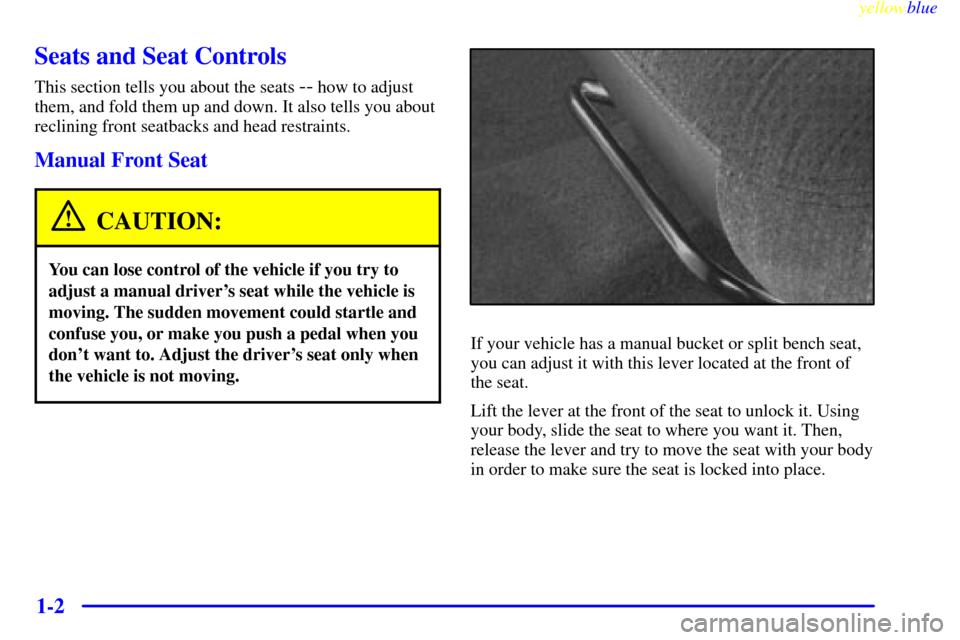
yellowblue
1-2
Seats and Seat Controls
This section tells you about the seats -- how to adjust
them, and fold them up and down. It also tells you about
reclining front seatbacks and head restraints.
Manual Front Seat
CAUTION:
You can lose control of the vehicle if you try to
adjust a manual driver's seat while the vehicle is
moving. The sudden movement could startle and
confuse you, or make you push a pedal when you
don't want to. Adjust the driver's seat only when
the vehicle is not moving.
If your vehicle has a manual bucket or split bench seat,
you can adjust it with this lever located at the front of
the seat.
Lift the lever at the front of the seat to unlock it. Using
your body, slide the seat to where you want it. Then,
release the lever and try to move the seat with your body
in order to make sure the seat is locked into place.
Page 18 of 421
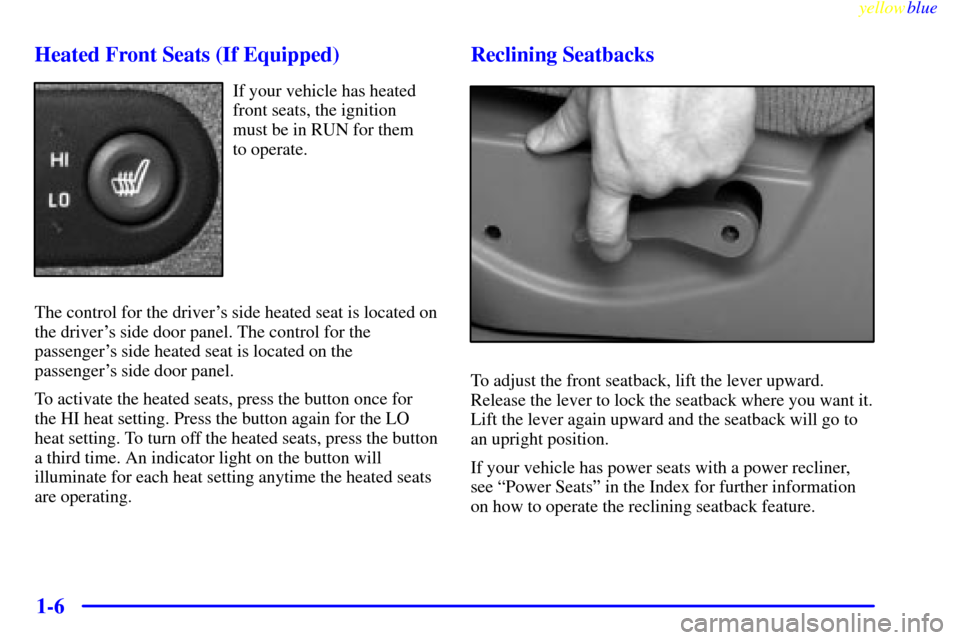
yellowblue
1-6 Heated Front Seats (If Equipped)
If your vehicle has heated
front seats, the ignition
must be in RUN for them
to operate.
The control for the driver's side heated seat is located on
the driver's side door panel. The control for the
passenger's side heated seat is located on the
passenger's side door panel.
To activate the heated seats, press the button once for
the HI heat setting. Press the button again for the LO
heat setting. To turn off the heated seats, press the button
a third time. An indicator light on the button will
illuminate for each heat setting anytime the heated seats
are operating.
Reclining Seatbacks
To adjust the front seatback, lift the lever upward.
Release the lever to lock the seatback where you want it.
Lift the lever again upward and the seatback will go to
an upright position.
If your vehicle has power seats with a power recliner,
see ªPower Seatsº in the Index for further information
on how to operate the reclining seatback feature.
Page 20 of 421

yellowblue
1-8 Head Restraints
Slide the head restraint up or down so that the top of the
restraint is closest to the top of your ears. This position
reduces the chance of a neck injury in a crash.
On some models, the head restraints tilt forward and
rearward also.
To tilt the head restraints forward, grasp the top of the
restraint and move it forward to where you want it to go
until you hear a click. It will then be locked into that
position until you need to move it again. Pulling it
forward past the last position will allow the restraint to
return to its upright position.
Seatback Latches
CAUTION:
If the seatback isn't locked, it could move
forward in a sudden stop or crash. That could
cause injury to the person sitting there. Always
press rearward on the seatback to be sure it
is locked.
The seatbacks fold forward to let you access the rear of
the cab.
To fold a front seatback
forward, pull this lever
forward and fold the
seatback forward.
To return the seatback to the upright position, just push
the seatback rearward until it latches. After returning the
seatback to its upright position, pull the seatback
forward to make sure it is locked.
Page 21 of 421
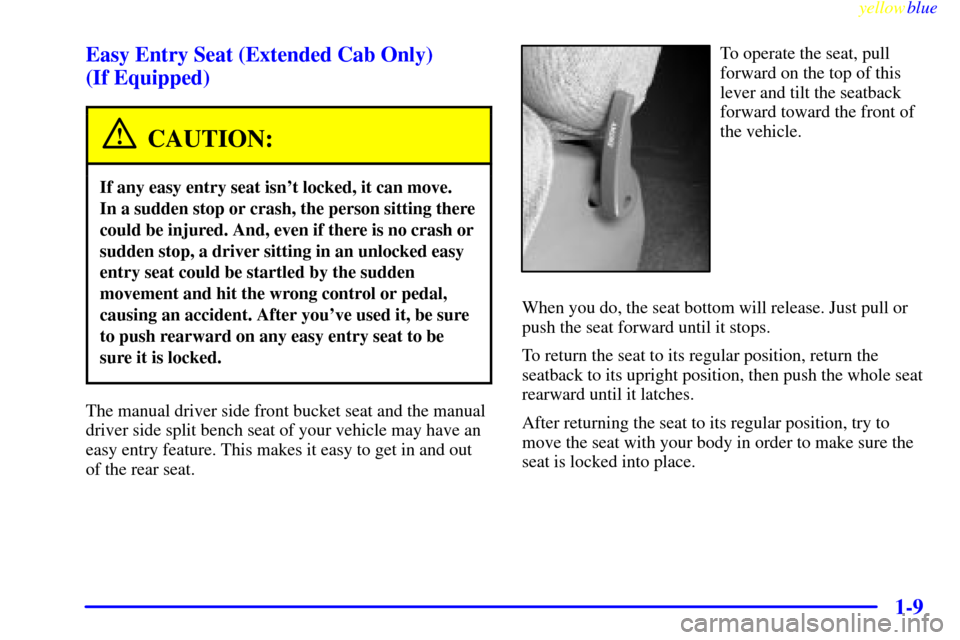
yellowblue
1-9 Easy Entry Seat (Extended Cab Only)
(If Equipped)
CAUTION:
If any easy entry seat isn't locked, it can move.
In a sudden stop or crash, the person sitting there
could be injured. And, even if there is no crash or
sudden stop, a driver sitting in an unlocked easy
entry seat could be startled by the sudden
movement and hit the wrong control or pedal,
causing an accident. After you've used it, be sure
to push rearward on any easy entry seat to be
sure it is locked.
The manual driver side front bucket seat and the manual
driver side split bench seat of your vehicle may have an
easy entry feature. This makes it easy to get in and out
of the rear seat.
To operate the seat, pull
forward on the top of this
lever and tilt the seatback
forward toward the front of
the vehicle.
When you do, the seat bottom will release. Just pull or
push the seat forward until it stops.
To return the seat to its regular position, return the
seatback to its upright position, then push the whole seat
rearward until it latches.
After returning the seat to its regular position, try to
move the seat with your body in order to make sure the
seat is locked into place.
Page 22 of 421
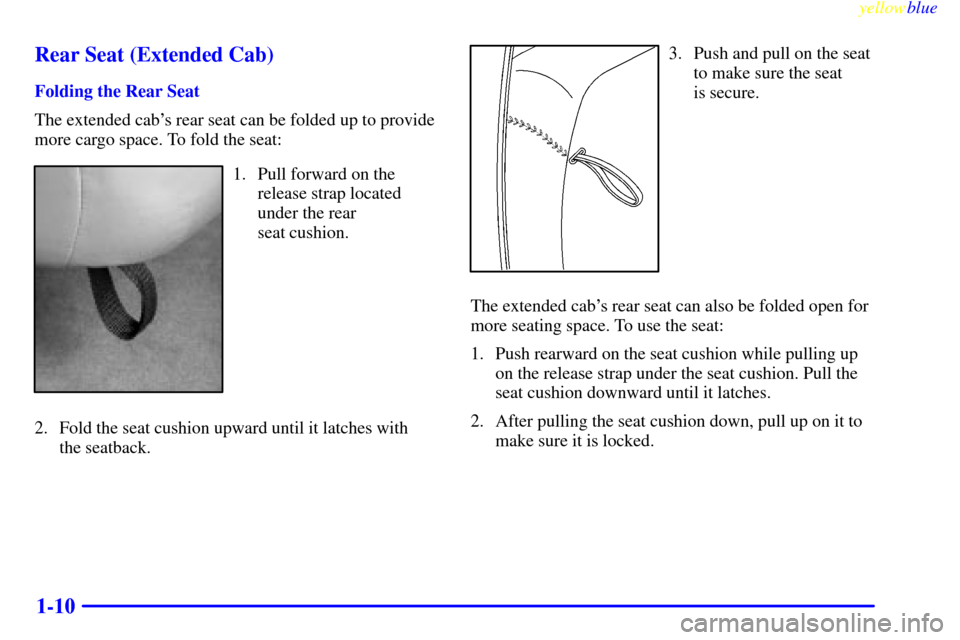
yellowblue
1-10 Rear Seat (Extended Cab)
Folding the Rear Seat
The extended cab's rear seat can be folded up to provide
more cargo space. To fold the seat:
1. Pull forward on the
release strap located
under the rear
seat cushion.
2. Fold the seat cushion upward until it latches with
the seatback.
3. Push and pull on the seat
to make sure the seat
is secure.
The extended cab's rear seat can also be folded open for
more seating space. To use the seat:
1. Push rearward on the seat cushion while pulling up
on the release strap under the seat cushion. Pull the
seat cushion downward until it latches.
2. After pulling the seat cushion down, pull up on it to
make sure it is locked.
Page 29 of 421
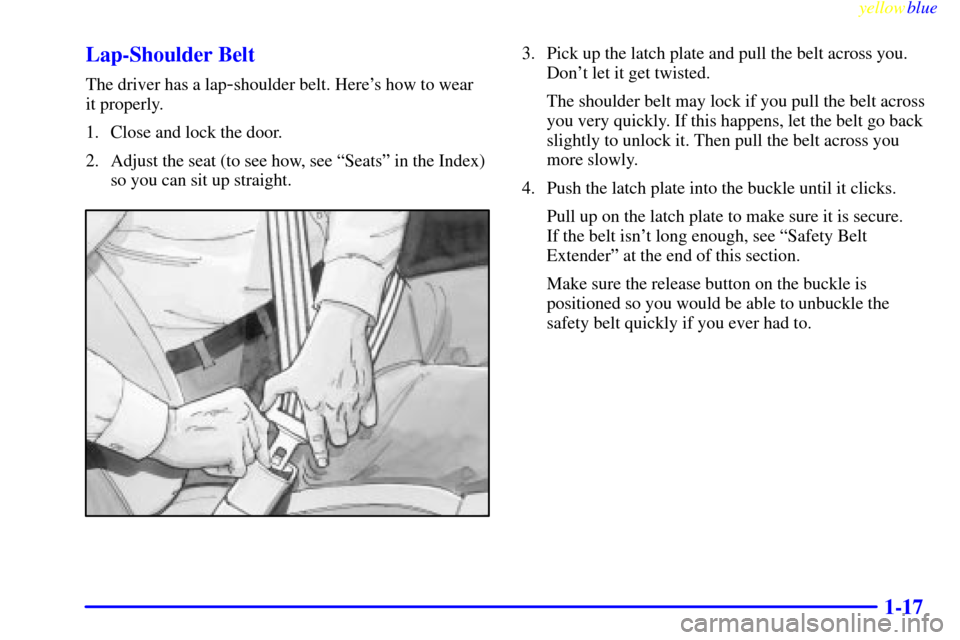
yellowblue
1-17 Lap-Shoulder Belt
The driver has a lap-shoulder belt. Here's how to wear
it properly.
1. Close and lock the door.
2. Adjust the seat (to see how, see ªSeatsº in the Index)
so you can sit up straight.
3. Pick up the latch plate and pull the belt across you.
Don't let it get twisted.
The shoulder belt may lock if you pull the belt across
you very quickly. If this happens, let the belt go back
slightly to unlock it. Then pull the belt across you
more slowly.
4. Push the latch plate into the buckle until it clicks.
Pull up on the latch plate to make sure it is secure.
If the belt isn't long enough, see ªSafety Belt
Extenderº at the end of this section.
Make sure the release button on the buckle is
positioned so you would be able to unbuckle the
safety belt quickly if you ever had to.
Page 30 of 421
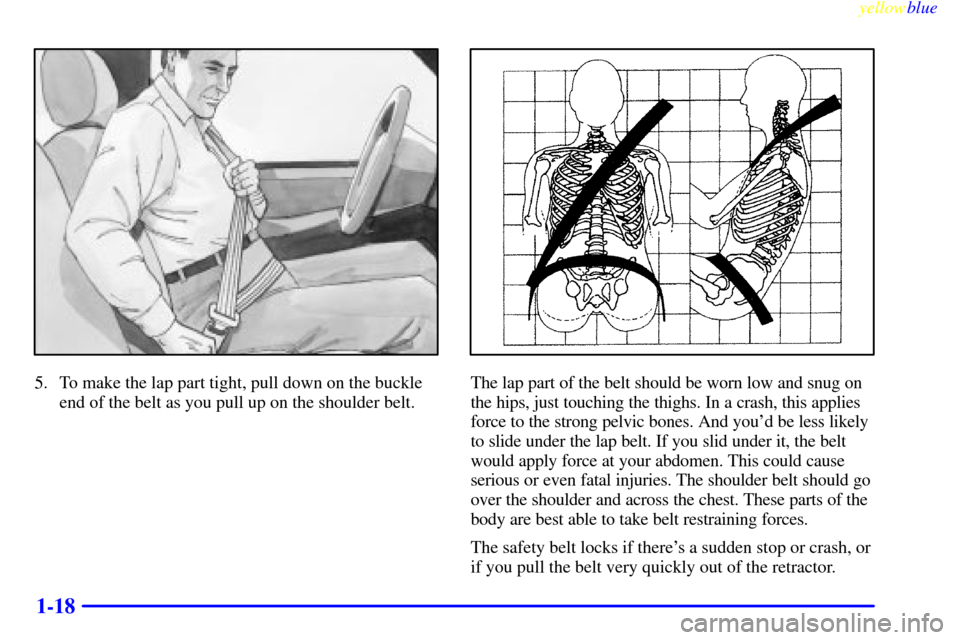
yellowblue
1-18
5. To make the lap part tight, pull down on the buckle
end of the belt as you pull up on the shoulder belt.The lap part of the belt should be worn low and snug on
the hips, just touching the thighs. In a crash, this applies
force to the strong pelvic bones. And you'd be less likely
to slide under the lap belt. If you slid under it, the belt
would apply force at your abdomen. This could cause
serious or even fatal injuries. The shoulder belt should go
over the shoulder and across the chest. These parts of the
body are best able to take belt restraining forces.
The safety belt locks if there's a sudden stop or crash, or
if you pull the belt very quickly out of the retractor.